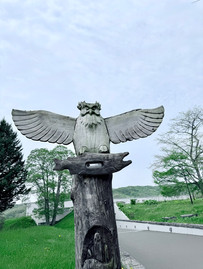The Power of One
- Evangelia Papoutsaki
- Jul 2
- 3 min read
As I prepared to leave Hokkaido after spending several months as part of my Japan Foundation research fellowship, hosted by Hokkaido University, I reflected on the “power of one”—whether it be an individual, a family, a group, or a community—in advocating for Indigenous rights. I also wish to highlight the importance of critical allies in supporting Indigenous causes.
While exploring Ainu culture and Indigenous tourism, I was fortunate to meet remarkable people and gain access to communities and projects that demonstrated how the power of one can spark meaningful change. https://www.bbc.com/.../20200519-japans-forgotten...
One such individual is Kenji Sekine from Nibutani, a vital Ainu community dedicated to cultural restoration and revitalization. To me, Kenji embodies the profound impact a single person—and, in this case, a critical ally—can have. Though not Ainu himself, he married into a prominent Ainu family and now leads Ainu language revitalization with unwavering dedication. His work left a deep impression on me. When I asked if he considers his efforts a form of activism, he replied emphatically: Yes! Fighting for an Indigenous people’s right to reclaim and use their language is, he said, a political act. And he does this from the ground up—teaching Ainu at the community school, advising on language use, networking with other Indigenous groups, and even learning Te Reo Māori to adapt its teaching methods for Ainu. His mission is daunting, given how few speakers remain, yet he persists with remarkable determination. You can read an interview with him and his daughter: https://www.bbc.com/.../20250625-can-ai-speak-the...
Kenji builds upon the legacy of another pivotal figure: Kayano Shigeru, a politician and leading force in Japan’s Ainu ethnic movement. One of the last fluent Ainu speakers, Kayano hailed from Nibutani, and his extensive collection of Ainu artifacts now forms the core of the Nibutani Ainu Culture Museum—a beautifully intimately curated space that stands as a testament to one man’s devotion to his people.
Of course, individuals do not act alone. Kenji’s family is also a driving force in Ainu cultural revival. His wife, Maki, is a renowned Ainu pattern designer; his daughter promotes Ainu rights through social media; and his mother-in-law plays a key role in reviving traditional crafts.
Nibutani left a lasting mark on me—not only because of these individuals but also due to community-led initiatives like the Ainu Culture Transmission in the Forest project, which seeks to restore the Indigenous connection to nature and the forest’s original biodiversity. Thanks to my Hokkaido University colleague, Mayumi-sensei, we were granted rare access to their work and even experienced traditional hunting practices. I was deeply moved—and saddened—to learn that the hunter had to pay the National Park for permission to use fallen wood to carve his tools, despite his role in restoring the forest’s biodiversity. When I asked what inspired him, he explained that he realized he could not truly be a hunter without honoring his ancestors’ traditions, which are so deeply tied to nature. This, in turn, led him to reconnect with his Ainu language and identity—a gradual but profound awakening.
Nibutani is a vital hub for Ainu culture, language, and ecological restoration. During an oral history performance at a Cise (Ainu house), I noticed most attendees were locals, including two elderly women with tears in their eyes. What must it feel like to hear your language spoken openly after generations of suppression? My own eyes welled up as I recalled my grandmother speaking to me in our Cretan dialect, which had survived centuries of foreign occupation. Yet I could scarcely imagine the resilience required to preserve Ainu identity under such erasure.
But here we are—not all is lost, thanks to these inspiring individuals and their tireless efforts. So never underestimate the power of one.
**With deep gratitude to all those who made it possible to visit this Ainu community, especially Kenji Sekine and Mayumi Okada. I hope to return and continue engaging with these inspiring individuals and communities.
































































Comments